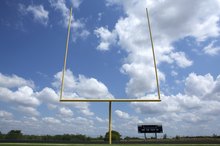Optimum Running Weight
While weight can be a touchy subject in any conversation, it plays a critical factor in running. Optimum running weight consequently has stirred debate in running circles for years, chiefly over a primary question: What exactly is an optimum running weight?
Coaches and dietitians alike rate weight--and more specifically excess body fat--as a key factor behind running performance. In short, the less excess body fat, the better your running performance.
Identification
Frequent running burns fat and promotes weight loss, but the optimum weight for a runner depends on height. The Stillman Table is one proven formula for figuring out height-weight ratio. For a non-active man, the formula allocates 110 lbs.
for the first 5 feet of height and 5.5 lbs. for every inch thereafter. For a non-active woman, the formula allocates 100 lbs.
for the first 5 feet and 5 lbs. for every inch above.
Assuming a male is 6 feet tall and weighs 176 lbs.
and a female is 5 feet, 6 inches tall and weighs 130 lbs., the Stillman Table speculates on optimum weight for certain running categories.
Sprinters should be 2.5 percent lighter (about 4 lbs. ); hurdlers should be 6 percent lighter (about 9 lbs. ); middle distance runners should be 12 percent lighter (about 19 lbs. ); and long distance runners should be about 15 percent lighter (about 25.5 lbs.). There are exceptions to the rule; however, a staggering percentage of world-class runners weigh at least 10 percent less than average, lending credence to the Stillman Table and the theory that less body fat improves running performance.
- Frequent running burns fat and promotes weight loss, but the optimum weight for a runner depends on height.
- and long distance runners should be about 15 percent lighter (about 25.5 lbs.
- ).
Goal
A Marathon Runner's Weight and Speed
Learn More
For a runner who falls into the non-active category as defined by the Stillman Table, a good initial goal is to reduce your body weight by 10 percent, writes Frank Horwill on the website Peak Performance. Achieving this goal depends on a number of factors, not least of which are calorie intake and how long the runs are. Humans require 2,500 calories per day on average, reports Horwill; a steady, daily 10-mile run will burn 1,000 calories that need to be replaced.
If a runner consumes 5,000 calories a day, he will actually gain weight in spite of those 10-mile runs. One approach for distance runners suggests aiming for a body weight 20 percent below average relative to height and limiting fat intake to 35 g per day, adds Horwill.
- For a runner who falls into the non-active category as defined by the Stillman Table, a good initial goal is to reduce your body weight by 10 percent, writes Frank Horwill on the website Peak Performance.
Diversifying Runs
One rule of thumb posits that every extra pound of non-productive body fat decreases running performance by 1 percent, writes Rick Morris in RunningPlanet.com.
That said, there are a number of methods a runner can use to achieve optimum running weight. Diversifying the length and types of runs you do throughout the week can effectively shave off the pounds.
Extending your weekly long run is a good place to start, adds Morris. Most runners burn up to 120 calories per mile.
Lengthening your weekly long run by just 3 miles can add up to 400 more burned calories.
Similarly, adding a mid-week long run can also help you reach an ideal running weight. For instance, a distance runner who includes a mid-week 12-mile run will burn up to 1,500 calories weekly. Hills are also an important venue for burning fat. Uphill running burns more calories than running on a level surface and simultaneously builds metabolically active leg muscles--and a higher metabolism means greater fat-burning potential.
- One rule of thumb posits that every extra pound of non-productive body fat decreases running performance by 1 percent, writes Rick Morris in RunningPlanet.com.
- Lengthening your weekly long run by just 3 miles can add up to 400 more burned calories.
Strength Training
Normal Weight for a 5'4" Girl
Learn More
Strength training can be an important corollary to a typical running regimen, as well as an asset in reaching optimum running weight.
Like hill-running, time spent in the gym can build metabolically active muscles that consequently lead to a higher metabolism. Upper and lower body strength exercises can also improve running performance.
Dietary Tweaking
Key shifts in diet are necessary. Avoiding simple carbohydrates is one such shift, but include sufficient complex carbohydrates, as they are essential to runners since they provide nutrient content that delivers energy during a run.
Portion size is another critical factor. For eating at home, prepare a portion size that won't tempt you to overeat. At a restaurant, you may have to consciously stop eating after a certain amount as portion sizes may not conform to dietary recommendations. Eating slowly can help alleviate this quandary by allowing your hunger to catch up with your consumption.
Finally, eliminating certain beverages can be important in achieving optimum running weight. Carbonated drinks are a primary culprit; most 12-ounce cans contain up to 200 calories. Carbonated drinks account for a significant percentage of adult caloric intake. Scratching such beverages from the diet can make a big difference in pursuing an ideal running weight.
- Key shifts in diet are necessary.
- Scratching such beverages from the diet can make a big difference in pursuing an ideal running weight.
Related Articles
References
- Kozlovskaia M, Vlahovich N, Rathbone E, Manzanero S, Keogh J, Hughes DC. A profile of health, lifestyle and training habits of 4720 Australian recreational runners-The case for promoting running for health benefits. Health Promot J Austr. 2019;30(2):172-179. doi:10.1002/hpja.30.
- Kerksick C, Harvey T, Stout J, et al. International Society of Sports Nutrition position stand: nutrient timing. J Int Soc Sports Nutr. 2008;5:17. doi:10.1186/1550-2783-5-17
- Donnelly JE, Blair SN, Jakicic JM, et al. American College of Sports Medicine position stand. Appropriate physical activity intervention strategies for weight loss and prevention of weight regain for adults. Med Sci Sports Exerc. 2009;41(2):459-71. doi:10.1249/MSS.0b013e3181949333.
- Chtourou H, Souissi N. The effect of training at a specific time of day: a review. J Strength Cond Res. 2012;26(7). doi:1984-2005.10.1519/JSC.0b013e31825770a7
- Tchernof A, Després JP. Pathophysiology of human visceral obesity: an update. Physiol Rev. 2013;93(1):359-404. doi:10.1152/physrev.00033.2011.
- Vissers D, Hens W, Taeymans J, Baeyens JP, Poortmans J, Van gaal L. The effect of exercise on visceral adipose tissue in overweight adults: a systematic review and meta-analysis. PLoS ONE. 2013;8(2):e56415. doi:10.1371/journal.pone.0056415.
- Verheggen RJ, Maessen MF, Green DJ, Hermus AR, Hopman MT, Thijssen DH. A systematic review and meta-analysis on the effects of exercise training versus hypocaloric diet: distinct effects on body weight and visceral adipose tissue. Obes Rev. 2016;17(8):664-90. doi10.1111/obr.12406.
- Johns Hopkins Medicine. 8 Ways to Lose Belly Fat and Live a Healthier Life. The Johns Hopkins University, The Johns Hopkins Hospital, and Johns Hopkins Health System. https://www.hopkinsmedicine.org/health/healthy_heart/eat_smart/8-ways-to-lose-belly-fat-and-live-a-healthier-life
Writer Bio
Lee Simmons has 10 years of reporting experience covering a variety of issues for publications in South Carolina, California, and Texas. He also covered music industry issues for Soundcheck magazine and Bizmology.com, among others. Simmons earned a journalism degree from the University of Texas. He lives in Austin.









